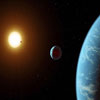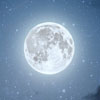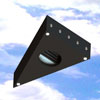Early Evidences Of An Inhabited Solar System
 by Daniel Ross
by Daniel Ross
Venus, Mars, and the Moon are important in that they are our closest neighbors, and the habitability can easily be determined. Our space program of the 1960s and 70s probed and photographed them extensively, since these planets were known to be the homes or bases of the UFOs. Life beyond the Earth should have been published as an established fact years ago. Two things prevented this from becoming our rightful knowledge; the inability, and often the refusal, of the orthodox scientists to go beyond their shared perceptions; and secondly, the absolute secrecy and censorship by the top-level authorities in charge of the space program.
But what about the other planets in our solar system? Are they inhabited also? And are their environments Earth-like, or similar enough, that we could travel to them and step out on their surfaces?
George Adamski stated early on that they were inhabited, for he got his information direct from the space people. Textbook scientists and JPL staff say no, based on the old theories, but they do not have any direct information from scientific instruments. To date, scientists have no way of knowing, because we have not probed beneath the atmospheres of the other planets or landed any instruments. And until they understand the true nature of the sun’s energy, gravity, and magnetic fields, their speculations will be way off the mark.
All that has been achieved is some preliminary picture-taking from vast distances during momentary flybys. For example, the closest pass to Jupiter by a Voyager probe was at a distance of 166,000 miles. Any so-called measurement from that distance would be purely hypothetical. And until scientists can see the UFO evidence here on Earth, and see the true environments of Venus, Mars, and the Moon, there is no reason to accept their opinions regarding the more distant planets. Their speculations are only extensions of theories that have become scientific dogma. There is simply no data which could prove or disprove the theories. In other words, from a purely scientific standpoint, the planetary conditions on either Mercury, Jupiter, or Saturn is still an open question. The same is true for the planets beyond Saturn.
In order to discuss Mercury, the last of the four inner planets of our system, it is important to first have a true perspective of spatial distances. Diagrams in books and magazines are invariably out of proportion due to an inadequate page size, and Mercury is perceived as being very close to the Sun. In space the planet’s actual distance from the Sun is 34 million miles.
The following is an accurate representation that could be laid out in a large yard or playground. If the Sun were the size of a regulation basketball, the Earth would be the size of a small BB placed 90 feet from the basketball. A smaller BB for Mercury would circle the basketball from a distance of 33 feet. To complete this scaled representation, a BB for Venus would be placed at 65 feet, and another for Mars at 132 feet. The actual size of a BB is 6 mm. Try and picture in your mind these sizes and distances for a moment.
Seeing Mercury as a small BB located 33 feet from the basketball, we find that it is not really close when seen at true scale. The planet is usually described as being very similar to the Moon on its surface, and like the Earth on the inside. As early as 1962, radio astronomers found that the night side hemisphere had a warm surface – an effect which would require that an atmosphere be present to carry the heat from the day side to the night side. It was also determined from further studies that Mercury had a thin atmosphere. The methods used were similar to those used for the Moon, (and like the case of the Moon, this means that the density of Mercury’s atmosphere will have to be revised upwards when more accurate methods are employed), when the atmosphere is accurately determined, we will also learn that the surface temperatures on Mercury are quite moderate.
The U.S. space program has sent only one space probe to Mercury. The spacecraft, Mariner 10, was placed into a precise orbit that allowed three brief flyby encounters during a one year period from March 1974 to March 1975. These one and a half day encounters were the first close-up views of the planet, and a chance to investigate Mercury’s magnetic field and its interaction with the solar wind. The mission was also supposed to check up on the “tenuous” atmosphere determined from radio astronomy, but either the Mariner 10 instrumentation was incapable of registering atmospheric effects, or NASA deliberately denied Mercury’s atmosphere, the same as they have denied the Moon’s. If Mercury did not have a sufficient atmosphere to offset internal pressures, it would have disintegrated and returned to the elements of space long ago.
The Mariner 10 flybys were night side passes, and therefore photographs could not be taken at the close approach, but only from much greater distances during the orbital pass. In fact, it was the worst trajectory for photographing the planet’s illuminated surface, and the end results required complicated imaging back at Jet Propulsion Laboratories. Resolution was compromised also, due to the lack of Congressional funding for a proposed x-band transmitter, designed to top specifications. All of this should be understood when looking at the photos of Mercury taken by Mariner 10.
The pictures are black and white, and look like common pictures of the Moon. Only the daylight half of the planet was observed by Mariner 10 in two hemisphere photographs. The first was taken from 124,000 miles as the probe traveled toward Mercury, and the second from 130,000 miles as it was traveling away from the planet. Broad surface area photographs were transmitted as Mariner’s distance decreased to 11,000 miles, and while “looking back” as the spacecraft came out from behind the night side hemisphere. The scenes of highest resolution are indistinguishable from pictures taken by the early Ranger spacecraft missions to our Moon.
The spacecraft’s orbit brought it to a second pass of Mercury six month later. Its closest approach was 30,000 miles on September 21, 1974. The third and final pass in March of 1975 brought it to within 6,000 miles, but only very small areas were picked up with slightly improved detail. The reason given for the much-lessened opportunity was that there was a failure with one of the Earth-based antenna systems. However, a few high resolution transmissions, showing features of 3 kilometer size, discovered water or river channels in an area now dry. Orthodoxers suggested their standard silly interpretation: the features depicted in the photographs had resulted from the flowing of liquid rock. Generally, the other pictures look like the front side of our Moon – plains, craters, and flooded basins.
Space scientists were surprised to find a strong magnetic field at Mercury. This field acts as a protective shield to the sun’s energy, and thus creates a bow shock in the solar wind, which was also confirmed by the Mariner probe. Scientists found that the bow shock was comparable and equivalent to the Earth’s interaction with the solar wind.
Yet many conclusions came into conflict. The magnetic field at the surface was given as 1% of the Earth’s, but it is quite doubtful that our methods can accurately measure things we do not really understand, namely the gravitational and magnetic fields of planetary bodies. It has also been stated that the photographic flybys enabled the scientists to confirm the very slow (59 day) rotation rate of Mercury, due to the fact that the same hemisphere was in view at each of the 3 encounters separated by 6-month intervals. This apparently confirmed an earlier theory, that while circling the sun twice, the planet would rotate 3 times on its axis, giving a ratio of 2:3. But any multiple of 3 would present the same exact face at flyby. Since a strong magnetic field is required to create a strong bow shock in the solar wind, and since a strong planetary magnetic field is generally attributed to the fast rotation of a planet, I do not think that we have heard the final answer as to the length of a day on Mercury.
Because the public only sees the end results of a space mission as a series of photographic images in a magazine article, people are very apt to think of a planetary encounter as a live broadcast from space by the space probe. Actually, the probe is exploring in the dark, and its various instruments have uncertain sensitivities to atmospheric frequencies, radar waves, solar intensity, magnetic fields, and cosmic radiations. Photography is nothing more than limited electronic detection of surface illumination contrasts, which must be interpreted by computer imaging back on Earth. The various instruments send their non-absolute indications millions of miles to Earth in the form of very faint radio signals. These signals are barely discernible from the constant radio noise coming to Earth from space itself, and sometimes indistinct from the high frequency noise of the components used to receive the signals.
For example, eight scans by an ultraviolet spectrometer on Mariner 10 were sent back, and initially the signals were interpreted as Mercury having a moon, or satellite. Project scientists thought that they had discovered a moon circling Mercury. The readings were later identified as radio emissions from a 5th magnitude star that was light years away! And is this not the same type of instrument as the mass spectrometer – that device which has always been the instrument for subjective analysis of planetary atmospheres?
Our space probes operate in unknown zones, pick up some type of frequency, from some type of emission, in a vast and complex planetary field. Something registers, and a feeble signal is transmitted to an Earth-based receiver. Schooled in orthodoxy, project scientists try to interpret the signal. Our space probes are exploring and groping in the dark, so to speak. Their capabilities at present are like looking at a drop of water with a magnifying glass. Compare that with looking at a drop of water with an electron microscope, and you realize what stage of confirmative knowledge we are at in planetary exploration.
A Mariner 10 photograph of Mercury reveals that its surface does look like the Moon. In fact, its environment may be very much like the Moon. Readers of this book are aware that there is a lunar civilization and life-supporting conditions on our satellite. When we get the full and correct pictures of the Moon from our space agency, then we can expect to get the correct pictures of Mercury. In other words, since our Moon is inhabited (contrary to the official position of NASA), we may later find that Mercury shows a similarly inhabited environment, if and when we send out better space probes. Mariner 10 did not have the capability of proving or disproving life on Mercury. From a scientific standpoint, it is still an open question. But just as the electron microscope can reveal a whole new world of activity in the drop of water which the magnifying glass cannot see, so too will our probes discover the actual world of Mercury, when their capabilities are increased 10,000-fold. This same analogy can be applied to the present state of knowledge regarding Jupiter, Saturn, and beyond.
W.R. Drake’s researches into classical literature and ancient manuscripts found many references to Mercury. One of the suppressed biblical accounts, the Book of Enoch, describes how Enoch ws taken into space (the heavens) and transported to various planets, including Mercury. On this celestial journey he was shown the grand design and motions of the solar system. Enoch’s ancient account tells of the round shape of the Earth and how our world is inclined on its axis. That knowledge could only be learned from contact with a space civilization. Enoch went on to be an inspired prophet in the cradle of civilization in Sumeria.
Panini, a Sanskrit historian and writer, wrote an account of how he and others had been taken on space trips to Mercury and Venus by the friendly extraterrestrials during the fourth century A.D. The famous philosopher, scientist, and astronomer of the 18th century, Emmanuel Swedenborg, after publishing great works in scientific discoveries and fundamental theories, intimated that his knowledge had come from (telepathic) intuition originating with space people from Mercury. In 1866, three professional astronomers saw an unexplainable light on the night side half of Mercury. M.K. Jessup attributes this telescopic observation to a brilliant UFO close to the surface of the planet, just as UFOs have been seen over the Moon.
These are a few of the references to Mercury from the records of history. Intelligent men in the past learned, or otherwise gave indication, that Mercury was a living planet. In our recent history of space visitations, this fact has surfaced again. Officials are more certain with Venus and Mars, but the world has a lot of learning to do. On Earth, mankind laughs at the thought of a divine purpose to creation, denies that there is any other life within light years of our little spot in the galaxy, and contemptuously threatens this most beautiful globe with nuclear bombs. His mind is so divorced from cosmic principle and intuition, that we cannot call it intelligent.
Volumes have been written on Jupiter and Saturn, based on nothing but a belief. The theory that these planets are large bodies of swirling gases around a liquid core became a fundamental cornerstone of organized astronomy – forever entrenched, never questioned. The psychology of the situation is almost medieval, because the theory is taught as absolute fact by the theologians of science. And if one is paid as a scientist, one has to write and write, with the result that the original belief now expands into volumes of meaningless, nonsensical concepts. Suppositions upon supposition, until natural inquiry is stifled, then suffocated.
It was Einstein who said: “It is, in fact, nothing short of a miracle that the modern methods of instruction have not yet entirely strangled the holy curiosity of inquiry.” John Goethe, the great German philosopher, once declared that so-called education was expressly designed to make sensible people stupid.
The theories have not changed, but the present discourses of Jupiter and Saturn are based on the picture-taking flybys of the Pioneer and Voyager probes. The more sophisticated cameras were on the hardy Voyagers, and the closest approach to Jupiter was 166,000 miles by Voyager 1, while Saturn was passed at a 63,000 mile distance by Voyager 2 in August 1981. Most of the photography was taken from much greater distances. The two probes’ electronic scanning signals were converted into pictures back on Earth, and in the case of Jupiter, computer-enhanced into false color. We did get a few close-up images of both of the planets’ moons, and a more detailed look at Saturn’s rings.
The Voyager photos of Jupiter that were released show bright orange and red bands. This was an exaggeration, in order to support the usual description of Jupiter’s “storm-wracked atmosphere.” The actual colors as seen from space are soft blues and yellow, and blue-green. This was confirmed by California astronomer Andrew Young.
In reality, both planets have solid surfaces. Jupiter has atmospheric zones for thousands of miles above its surface, which balance and blend with the sun’s energy to make a habitable environment. The earth-like surface of Saturn lies many thousands of miles below its atmospheric firmament. Many advancements in understanding of electromagnetic fields and cosmic science will be required in order to replace the old theories with correct knowledge.
George Adamski gave a complete explanation for the habitability on the more distant planets, and the following is taken from his book, Flying Saucers Farewell:
“One of the most frequent problems encountered when giving a lecture on space is the insistence of scientists that the outer planets are devoid of light and heat. Their objection is that radiation from the sun is so weak at these vast distances that Pluto, for instance, would be at absolute zero or close to it, with a frozen atmosphere, and totally incapable of supporting life-forms of any type.
“This is the main argument brought against me when doubt is expressed about my meeting human beings from some of these other planets.
“The first thing to realize is that the sun does not emit light and heat in the form we observe here on Earth. Radiation from the sun does not manifest itself as light and heat until it penetrates the atmospheres of the planets themselves. Outer space is devoid of light as we know it. The light in outer space is a cold light caused by the phosphorescence of vast clouds of particles and gases responding to the radiation given off by the sun. To a human observer, outer space looks like a dark, vast void, filled with billions upon billions of tiny specks of multicolored lights. All of these tiny lights are in a state of continuous motion and activity.
“Radiation from the sun is composed of ultraviolet light, hard and soft X-rays, cosmic and gamma rays. The greater portion of these destructive rays are filtered out by a planet’s ionosphere and upper atmosphere. The innumerable, infinitesimal particles within a planet’s atmosphere emit visible light when excited by the sun’s filtered radiation. The earth absorbs these rays, and in return gives off infrared energy. Energy thus given off activates the atmosphere immediately surrounding the planet, thereby generating heat that keeps the planet warm.
“It is easy to see how this energy from the sun can encompass our earth. After all, we are only 93 million miles from the sun. But what about the planets that are more remote from the sun?
“According to standard textbooks, the radiation from the sun decreases inversely with the square of the distance. In layman’s language, this means that if you double the distance from the sun, the radiation would be only one-fourth as great. If you double the distance again, the radiation would be only one-sixteenth as great, and so on. If the sun’s radiation actually decreases at this rate, then the outer planets must indeed be in a state of perpetual coldness.
“What, then, is the answer? I know from personal experience that these outer planets have thriving civilizations, with climates and atmospheres similar to our own earth. The larger planets, such as Saturn and Jupiter, have much lower gravity than has been assumed by our scientists. Therefore, our explanation of gravity must be in error in some way.
“Our main problem now is not gravity but climate. How do these planets receive enough energy from the sun to exist in a similar state to Earth?
“A clue to this answer is found in the vacuum tube; more specifically it is found in the cathode ray tube. This tube, abbreviated CRT, is found in the ordinary home television receiver. In it we have a heater that raises the temperature of a cathode to a point at which it gives off electrons in great quantities. These electrons are negative in nature. High positive voltages are supplied to various grids and anodes in the tube.
“There are two types of electricity: positive and negative. The electron is negative and its counterpart, the proton, is positive. Just as the north pole of a magnet will attract the south pole of another magnet, the electrons attract the protons. Similar poles of magnets repel each other and so do similar charges of electricity. Likes repel; unlikes attract.
“The high positive voltages on the grids and anodes of the CRT attract the electrons from the cathode. The electrons are pulled toward the anodes with great speed, but, due to the type of construction of these anodes, most electrons rush right on through toward the next one. Theoretically, this could be continued for great distances by use of several different anodes and high positive voltages.
“Mercury, Venus, Earth and Mars are close enough to the sun to get good radiation. With the planets beyond Mars it is a different situation. At these distances the sun’s radiation has started to diminish. At this time it comes under the influence of the tremendous attracting force generated by the first asteroid belt which totally envelopes the central position of our solar system. The negative charge of the asteroid belt is great enough to attract the particles from the sun and pull them back up to their original speed. Because this belt is grid-like in construction, with thousands of openings and paths, similar to a window screen with air going through, the particles dash on through and enter the influence of the planets beyond.
“These, being negative in themselves, as are all planets, attract from space the positive particles they need for light and heat. At the same time infinite numbers of similar particles rush on past and are attracted by a second asteroid belt between Neptune and Pluto, where the process is repeated all over again. This furnishes Pluto and the last three planets with normal light and heat. (Twelve planets in all exist in our system, according to the space travelers.)
“A third asteroid belt is beyond the twelfth planet, serving a dual purpose of blending space within our system with that of neighboring systems. At the same time it serves as a protective filter, comparable to the ionosphere encompassing a planet.
“We might summarize by saying: The two inner asteroid belts gather rays from the sun and speed them on through space. They equalize, so to speak, conditions within the system from the area of Mercury right on to the outer reaches of our solar system, while the third keeps our system, as a unit, in balance with those beyond. Because of this cosmic activity, of which we on Earth have not previously been aware, we could go to any of our planets and enjoy a climate and atmosphere similar to our own.”
Following this discussion, Adamski explains how the asteroid belt acts as a dielectric (as in a capacitor which stores electrical energy) by trapping a portion of the sun’s energy, while at the same time imparting energy to particles passing through. This alternating-current action effectively makes the asteroid belt an incubator of electromagnetic energy. This net attraction of the sun’s positively charged particles should register as higher kinetic energy (temperature) by a space probe passing through the zone.
Voyager I passed this zone that lies between Mars and Jupiter in 1978, and found it to be the hottest spot ever measured in the solar system. The temperature was at least 100 times that of the sun’s surface. There is no real heat though, since the interplanetary region is a near-vacuum, whereas the plasma fields around the sun are extremely dense. Therefore, the Voyager probe was measuring high kinetic activity of solar particles in the asteroid belt, which is exactly the description given 17 years earlier by Adamski in his book.
The spaceships that Adamski went on were motherships from Venus and Saturn. The people he met on these craft were from Venus and Saturn, along with people from Mars – the three planets most responsible for helping the Earth in its transition towards the space age. But he was told that there was interplanetary cooperation throughout our solar system, and that people of all planets except Earth travel space freely. Every planet except Earth has spaceships.
Although Adamski’s main contacts were from the same group, occasionally he met others from our system. While in Mexico in 1957, he had visits by space people who lived and worked in that nation. Two that he met came from different planets, namely Jupiter and Neptune. Adamski related this information in a letter to a European correspondent, and stated simply that having met people from five different planets of our system, he found no more difference between them, than between various nationalities on Earth. Apparently, the information Adamski received was of a universal nature relating to their work on Earth. Adamski had explained in his three published books that the other planets besides Venus, Mars, and Saturn were inhabited, but he indicated that he was not given specific information regarding the other planets.
As related earlier, Adamski explained that there were three undiscovered planets beyond the orbit of Pluto, making a total of twelve planets in our solar system. This had first been revealed to him during a discussion on board a Venusian carrier ship, and stated in the book, Inside The Spaceships (1955). The simplicity of this statement lay dormant for 28 years.
Excerpt from UFOs And The Complete Evidence From Space
To continue reading see the full chapter here.
Posted in Life On Other Worlds, Other Topics, UFOswith no comments yet.






Leave a Reply